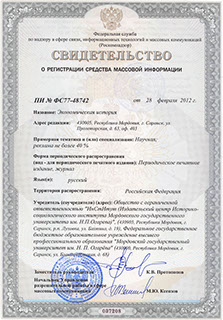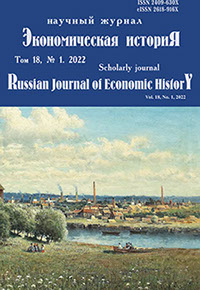Экономическая историЯ
Russian Journal of Economic History
ISSN 2409-630X (Print)
ISSN 2618-916X (Online)
Expert board:
- Scientific Council of RAS on economic history;
- Research and Educational Center «The economic history of Central Russia and the Middle Volga region» of Ogarev Mordovia State University;
- Center of Economic History of Lomonosov Moscow State University
Navigation
Certificate of registration

ISSN 2409-630X (Print), ISSN 2618-916X (Online)
DOI: 10.15507/2409-630X.056.018.202201.045-054
УДК 336.77
Tatyana I. Shcherbakova
National Research Ogarev Mordovia State University (Saransk, Russia),
e-mail: tatyana_shcherbakova@bk.ru
Economic Model of the Post-Stalinist USSR and its Results
Introduction. In 1930th – the 1950th years in the USSR the centralized planned command economic model was realized, where the main resources were aimed at the development of means of production. The production of consumer goods, as well as the wages of the population, were extremely limited, so the emission was the main source of development. After the death of
I. V. Stalin, his successors changed the model. They refused to maintain the balance of the economy and money circulation and redistributed part of the state’s income in favor of the population, by significantly increasing cash payments. Results of this model are investigated in the article. Materials and Methods. The study bases on the departmental documents of the State Bank of the USSR. They contain not only departmental statistical data, but also expert assessments, which in the article are compared with the results of modern researchers. Results. The growth of money incomes of the population led to an increase in the cash supply, which took place at an outstripping pace. The deficit of the economy could not be overcome. In the same years, producers’ cooperatives which partially satisfying the needs of the population were nationalized. Their employees have become unregistered private entrepreneurs, who produced goods and services in the shadow economy. A significant part of the population who produced and consumed these goods ensured the flow of money from the official economy to the shadow one. Another part of the excess money was deposited in savings accounts. Ignoring the shadow sector parasitizing the deficit problem, the Soviet leadership did not stop attempts to solve it. A significant part of the USSR’s oil and gas revenues was spent on consumer goods. The result of the implemented economic policy was the inflationary bubble and the growth of the shadow economy. Discussions. The transition to a new economic model can be explained by the fatigue of the ruling class from the stress of previous decades, as well as the populism of Stalin’s successors. Through the production of the consumer goods, the official economy was tightly connected with the shadow one, which began to grow rapidly at the expense of budget funds, subjugating state trade, generating deficits, and corrupting the government machinery. The government lost the fight against the shadow economy, and in fact, ignored its presence. At the end of 1980th the Soviet economy collapsed. Conclusion. The transition to a new economic model led to the long-term destabilization of money circulation and to the concentration of money, which was not provided with goods and services. The failure of the government to stabilize money circulation and solve the problem of commodity deficit has caused an increase in unmet demand, as well as the growth of the shadow economy. The inability of the government to break the link with the parasitic shadow economy and stop the growth of the cash supply predetermined the economic collapse of the USSR.
Keywords: Soviet economy, Soviet society, cash supply, trade turnover, commodity deficit, unmet demand, shadow economy, savings deposits, monetary incomes of the population.
For citation: Shcherbakova T. I. Economic Model of the Post-Stalinist USSR and its Results. Ekonomicheskaya istoriya = Russian Journal of Economic History. 2022; 18(1): 45–54. (In Russ.). DOI: 10.15507/2409-630X.056.018.202201.045-054.
© Ogarev Mordovia State University. History and Sociology Institute, 2017
68, Of. 411, Bolshevistskaya St., 430005, The editorial office of the scholarly journal «Russian Journal of Economic History»
Tel.: (8342) 24-25-90; 27-07-11, Fax: (8342) 24-25-90, E-mail: jurnal-econom-hist@isi.mrsu.ru
Designed by A. Napalkov, Email: napalkov@isi.mrsu.ru

